

Nationalgeographic. Nonprofits! This Is How to Use Facebook’s Fundraising Tools. Through a process of trial and error, the Beagle Freedom Project is learning how to effectively use Facebook’s Fundraising Tools and they are being rewarded with more than likes and hearts – their followers are donating!
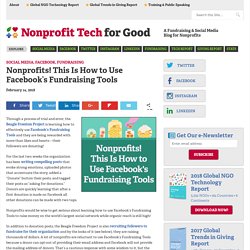
For the last two weeks the organization has been writing compelling posts that evoke strong emotions, uploaded photos that accentuate the story, added a “Donate” button their posts, and tagged their posts as “asking for donations.” Donors are quickly learning that after a first donation is made on Facebook all other donations can be made with two taps. Nonprofits would be wise to get serious about learning how to use Facebook’s Fundraising Tools to raise money on the world’s largest social network while organic reach is still high!
The Andrew W. Mellon Foundation. CSR / Environment. The Simple Blueprint for Successful Crowdfunding Campaigns. Every successful crowdfunding campaign starts with a good story.
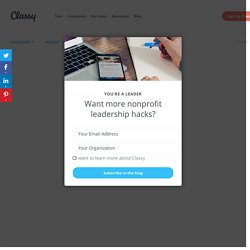
Whether you’re raising money for potato salad or solving world hunger, a single catalyzing moment exists behind the need for a campaign. There’s a story behind that moment. Nonprofit Recognition: What Matters More To Visitors Than Your Tax Status. 4 More Clever Ways to Improve Your Thank You Letters. As we mentioned last week, first-time donor retention is a measly 19%.
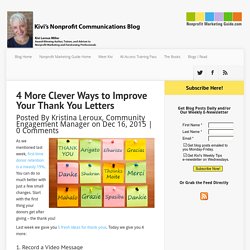
You can do so much better with just a few small changes. Start with the first thing your donors get after giving – the thank you! Last week we gave you 5 fresh ideas for thank yous. Today we give you 4 more: 1. One of my all-time favorite thank-you emails came from The Nature Conservancy (TNC), with a link to a short video. 2. Several digital photo apps let you turn your photos into instant postcards (see Postagram or Touchnote, for example). 3. Very quickly but clearly describe a specific program where the gift will be used.
15 Creative Ways to Thank Donors - Best practices, tips & fundraising ideas for nonprofits. Posted December 15, 2015 by Chelsea Alves The most important thing you’ll ever do to steward your donors is say thank you.

Just about every nonprofit leader or fundraiser knows the importance of thanking donors—not just as an expression of gratitude and good manners, but as a way of building relationships. When done well, recognition can even encourage future gifts and continued involvement, whether through volunteering or being an ambassador for the organization. It also helps encourage gifts from other networks. When people see their friends and family members are passionate about a cause, they might consider supporting as well. When it comes to giving thanks, small and medium-size organizations may not have the resources or opportunities for lavish gifts or swanky appreciation events. How to Leverage Welcome Emails to Retain New Donors. Posted December 17, 2015 by Elizabeth Chung You’ve worked hard to get a prospect to finally donate, but now comes the real challenge: getting them to stay.

While organizations focus intently on the acquisition process, they still struggle to retain donors after the fact. Only 27 percent of first time donors stay with an organization. The Chronicle of Philanthropy - The news and tools you need to change the world. By Holly Hall, Eden Stiffman, Ron Coddington, and Meredith Myers Charitable giving rose 5.4 percent last year to a record $358.4 billion, according to estimates released today by "Giving USA," the annual snapshot of American philanthropy.
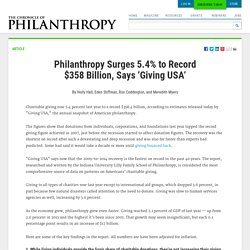
The figures show that donations from individuals, corporations, and foundations last year topped the record giving figure achieved in 2007, just before the recession started to affect donation figures. The recovery was the shortest on record after such a devastating and deep recession and was also far faster than experts had predicted. Some had said it would take a decade or more until giving bounced back.
"Giving USA" says now that the 2009-to-2014 recovery is the fastest on record in the past 40 years. Giving to all types of charities rose last year except to international aid groups, which dropped 3.6 percent, in part because few natural disasters called attention to the need to donate. As the economy grew, philanthropy grew even faster. 1. 2. Top 9 Online Fundraising Blogs for Nonprofits. Fundraising online for a nonprofit initiative or cause has a lot of moving parts.
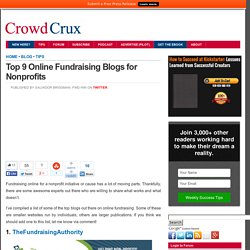
Thankfully, there are some awesome experts out there who are willing to share what works and what doesn’t. I’ve compiled a list of some of the top blogs out there on online fundraising. Some of these are smaller websites run by individuals, others are larger publications. If you think we should add one to this list, let me know via comment! 1. The Fundraising Authority has a wealth of information about how to run a successful nonprofit fundraising campaign. 2. “Reach your fundraising goals with our library of expert advice, donor communication tips, and nonprofit marketing resources.” This website includes tips on social media outreach, managing donors, storytelling, running events, and more. Who Gives to Crowdfunding Events? Analytics for a Digital World - comScore, Inc.
Pew Research Center's Internet and American Life Project. GlobalGiving: donate to projects around the world supporting disaster relief, education, health, women and children, and more.